There are a lot of outstanding reasons to pick up an electric bass guitar. Maybe you love the classic sound of a four-string Fender Precision Bass, the low-end rumble of an extended-range five- or six-string machine made for modern metal, or the sweet song of a fretless. You might be a guitarist who wants to have a backup plan, or a home recordist who wants to lay your own bass tracks. Or, you might be someone who loves the idea of being an informal conductor (a role bassists often play, usually uncredited). Maybe you just like making the world rattle. We know that there are a lot of choices, and, at Guitar Center, we understand that the desire to make music is a very powerful one. From Hofner Violin basses to Guild acoustics to modern, multi-scale Ibanez instruments, this guide will introduce you to the basics (or bass-ics) of making sure your next instrument is the best electric bass guitar for your needs.
Stick with us through the next couple of sections to get some inside information about the history and development of the electric bass, as well as some tips that will help you decide just which bass you want. Or, if you want to get straight to the gear, use the links in our convenient Table of Contents to jump directly to the sections that interest you.
If you're just starting out on bass, be sure to check out our collection of beginner bass guitars.
Table of Contents
What You'll Need to Know
Four-String Foundations
The Groundbreakers
Other Iconic 4-Strings
Five- and Six-String Options
Short-Scale Basses
Fretless Bass-ics
Active Basses
Acoustic Basses
Best Beginner Choices
The Bottom Line
What you'll need to know
So what do you need to think about when buying a bass guitar? There are a lot of things to consider. From the kind of music you want to play and what type of bass sounds you like to how big your hands are, let’s dig into what will help you decide on the bass that’s right for you.
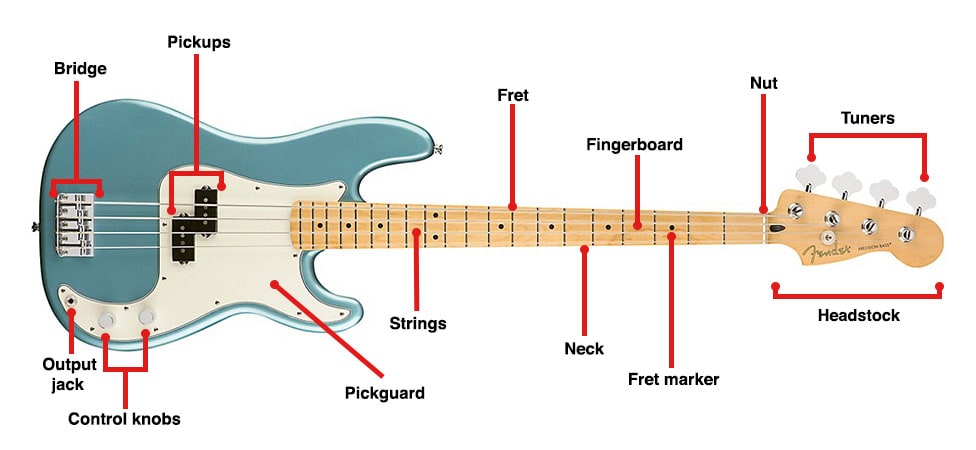
Scale Length
The scale length of a bass is the length of the vibrating portion of the string. This is measured from the bridge to the nut. There are four basic classes of scale length: Short (less than 30”), Medium (30–33”), Long (34”) and Extra-Long (35”+). Most basses fall into the long-scale category because that was the scale of the earliest electric bass, the Fender Precision Bass.
Which one will be best for you depends on the fundamental tone you want and how large your hands are. The longer the scale, the more tension it takes to get a string to pitch. The more tension, the stiffer the string feels and the more piano-like the tone is. Changing the scale length also changes the basic tone, or timbre, of a note due to changes in the ratio of tones in the harmonic series generated by the string’s vibratory length. So a short-scale bass will have a richer low-end tone and a smoother high end. A longer scale makes for a brighter high-end tone and more “twang” in the low end. So, that’s one thing to consider.
The other consideration is that bass guitar, especially a longer-scale bass, can be a physically demanding instrument to play due to the distance between frets, especially in the lower positions. Think of it this way—a four-fret stretch from the nut on a standard 34”-scale neck is just about the equivalent to a seven-fret stretch on a 24.75”-scale guitar. This is one reason why, despite legendary Booker T & the MGs bassist Duck Dunn’s proclamation that, “There’s no money above the seventh fret,” when you see bass players soloing, it’s mostly in upper registers where frets are closer together. So, for younger players or players with smaller hands, a short-scale bass can be a good place to start. This is not to say that small hands can’t play long-scale basses, but if you fall into that category, try them all, and go with what’s physically most comfortable.
Pickup Type
Like electric guitars, the electric bass has pretty much two basic types of pickup to choose from—single coil or humbucking. Single-coil pickups have a wider frequency bandwidth (more highs, more lows), but can be more prone to picking up electrical noise and interference. Humbucking pickups have a second coil that’s wired in reverse polarity which helps cancel out unwanted noise at the cost of losing a little bit of highs and lows. This results in a generally thicker tone, but with a little less definition than a single-coil pickup.
An interesting variant is the Fender P-Bass-style split-coil pickup. While it may look like a single coil, the two halves of the pickup are wired in reverse polarity. This helps you get most of the noise rejection of a humbucker with most of the sound of a single coil. Clever.
Active or Passive
While we’re on the topic of electronics for your electric bass guitar, we need to touch on the subject of active and passive basses. The original electric basses all had unpowered passive electronics systems. This means that the tone controls can cut frequency ranges, but not boost them. Active, in basses, can mean either pickups that have a built-in preamp or a powered preamp that boosts and EQs the signal of passive pickups in the guitar. Active electronics always require power, either from an onboard battery or phantom power from an external power supply.
Don't Fret the Frets
The final electric bass variation we’ll look at before we dive into specific models is the question of frets. If you’re a fan of bassists like Jaco Pastorius, Pino Palladino, Les Claypool, Victor Wooten or Bill Wyman, you’re familiar with the sound of a fretless bass. The fretless electric bass used to be seen as a sort of oddball choice, but more and more bassists seem to be looking for that silky smooth, vocal-like tone and are willing to put in the extra hours refining their technique. While it may not be the ideal choice for an absolute beginner, if you’ve already been playing a while, a fretless can be a great addition to your arsenal. Just be ready to put in the practice time.
Four-string foundations
By far the most common electric bass guitar is the regular four-string version. It was originally designed both to enable guitar players to double on bass and to allow upright bass players to have a more portable instrument. The electric bass’ fourths-based tuning, based on the bottom four strings of standard guitar tuning, not only made it easier for guitarists to pick up, but actually helped to standardize E-A-D-G for orchestral double bass as well, as symphonic players and composers had only recently begun to use that tuning. Four strings is probably the best place for any beginner to start learning.
The Groundbreakers
The electric bass revolution began in October of 1951, with the release of the Fender Precision Bass (sometimes call the Telecaster bass because its slab body, Bakelite pickguard and single-coil pickup resembled the then-new Telecaster). The next evolution occurred a decade later, with the debut of the Fender Jazz Bass. These two basses not only broke new musical ground, but became so iconic, their design elements were and are echoed in many instruments from other manufacturers.
Fender Precision Bass
You really couldn’t design an instrument that was simultaneously as simple and as versatile as the original Fender Precision Bass, or P Bass. With a slab body and single pickup with volume and tone control, it was stripped down and easy to incorporate into any band that needed an amplified bass. Featuring a warm, punchy tone that could add a bit of bite and a neck that was instantly comfortable for the guitar players who were swapping over, it was an ideal fit for the small touring combos of the time. When Fender released the Stratocaster in 1954, the body shape of the Precision was modified to match the new guitar’s contours. In 1957, the signature split-pickup design was added. This basic design—streamlined and functional—has become so immediately identifiable that it has remained basically the same with only minor changes in finish and electronics choices.
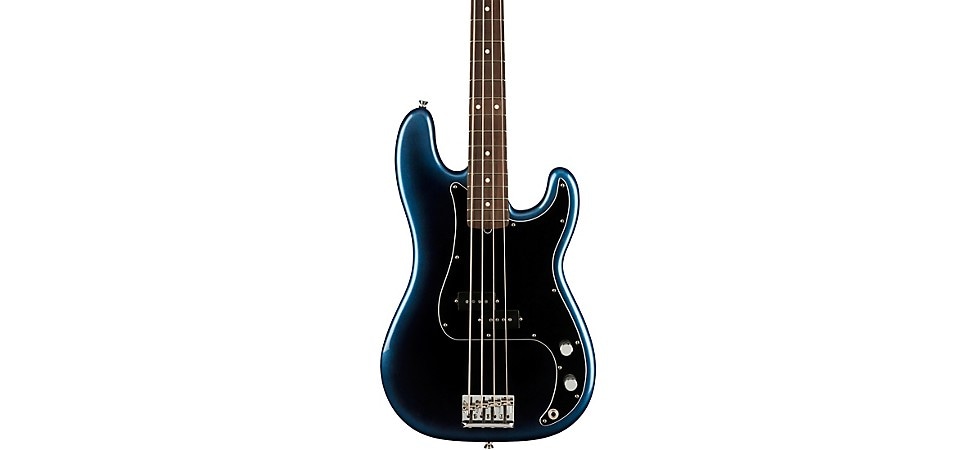
Shop Now: Fender American Professional II Precision Bass
Guitar Center offers a wide range of P Bass models in a huge variety of finishes, from entry-level Squier versions to Fender Custom Shop masterpieces.
Fender Standard Precision Bass
The Fender Precision Bass has been the backbone of countless recordings and performances since its introduction in 1951, and the Fender Standard Precision Bass brings that legacy to a broader audience. Built outside North America for the first time under the Fender name, this model retains the signature alder body, split-coil pickup and solid, road-ready feel that define the P Bass sound. Whether you’re after warm, thumpy lows or the punchy attack that cuts through a mix, this P Bass delivers—without compromise. Boasting Fender’s Modern C neck profile and medium jumbo frets, it's available with a 9.5" radius laurel or maple fingerboard, it’s an excellent choice for players looking for classic Fender craftsmanship at a more accessible price.

Shop Now: Fender Standard Precision Bass in Black
Fender Player II Precision Bass
From Roger Waters to Dee Dee Ramone and Brian Wilson to Duff McKagan, the illustrious Fender P Bass is a choice tool for musical legends, with a seven-decade history of reliable rhythmic performance across genres. If ever the adage applies, this storied 4-string has required virtually no fixing since its last great revision in 1957, and the Fender Player II Precision Bass inherits all the treasured characteristics of its ancestors—plus a few new touches for today’s players.

Shop Now: Fender Player II Precision Bass with Maple Fingerboard in Aquatone Blue
Featuring an alder body, 9.5"-radius modern C-shaped neck and a Player Series Alnico 5 split single-coil pickup, the Player II P Bass delivers the signature rounded tonality and earthquaking lows that have kept it within arm’s reach of the world’s top bassists for years. An outstanding mid-level workhorse for aspiring players and veterans alike, the Fender Player II Precision Bass offers a rosewood or maple fingerboard with select finishes, including classic colors and a few previously unseen hues from the vault.
Fender American Ultra II Precision Bass
The American Ultra II series is as good as it gets before you start getting into rarified Fender Custom Shop air. The American Ultra II P Bass rendition boasts an alder body; quartersawn, compound-radius (10"–14") maple neck with a Modern D profile; plus, your choice of an ebony or maple fingerboard. Other accoutrements include an S-1 switch on the volume knob that selects active or passive mode, active midrange frequency selector (325Hz or 750Hz), Luminlay side dots, Graph Tech TUSQ nut and an adjustable HiMass bridge that gives you the option of a string-through-body or top-load setup.

Shop Now: Fender American Ultra II Precision Bass in Texas Tea
Not only does this high-end rendition of the P Bass boast some of the finest materials and hardware—it also offers you an Ultra II Noiseless Vintage Jazz Bass bridge pickup in addition to its Ultra II Noiseless P Bass middle pup. So, if you can’t decide on whether to go in on a top-of-the-line Precision Bass or Jazz Bass, this might be the one.
Fender Jazz Bass
When Fender first released the Jazz Bass, or J Bass, in 1961, it wasn’t called that yet. Originally known as the Deluxe Bass, it borrowed an offset body design from the (then-new) Jazzmaster and Jaguar guitars. The narrower, but rounder, neck was intended to appeal more to jazz musicians than to the country, rock ‘n’ roll and R&B players who had so readily adopted the Precision Bass. A pair of single-coil pickups that could be mixed via individual volume and tone controls offered a much wider range of tonal options than previous basses, as well as more definition in both the low and high frequencies, and a distinctive mid-range growl. The earliest Jazz Bass had stacked pots with volume and tone for each pickup at a single-knob position. After a couple of years, this control setup was changed to the current setup of individual volume knobs and a master tone control. Some guitarists who double on bass find the Jazz Bass neck easier to shift to because, oddly enough, it feels a little less like a guitar, so it makes it easier to think of as a distinctly different instrument.
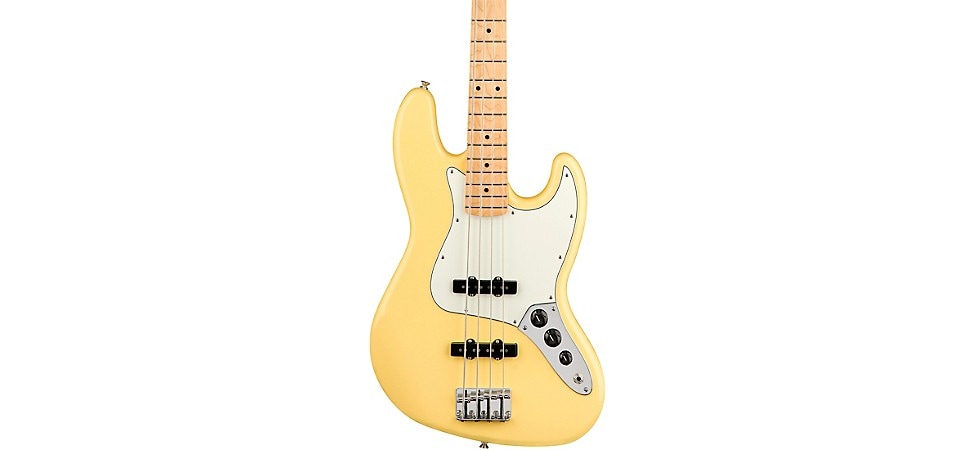
Shop Now: Fender Player Jazz Bass
Our selection of this model spans the full gamut, with versions for every level of player experience and budget.
Fender Standard Jazz Bass
Since its debut in 1960, the Fender Jazz Bass has been prized for its fast feel and articulate tone. The Fender Standard Jazz Bass marks a new chapter as the first J Bass built outside North America to carry the Fender logo, offering the same sleek offset body and dual single-coil pickups that have made it a studio and stage staple. Whether you’re playing tight, percussive fingerstyle lines or digging in with a pick, the Standard Jazz Bass keeps up with ease. The fast, slightly narrower neck is in Fender’s Modern C profile and features medium jumbo frets. With maple and laurel fingerboard options, it delivers a comfortable playing experience and the unmistakable tonal character that has made the Jazz Bass a favorite across genres for over 60 years.

Shop Now: Fender Standard Jazz Bass in Aqua Marine Metallic
Fender Player II Jazz Bass
Regarded as one of the greatest and most influential bass players of all time, Jaco Pastorius developed his inimitable voice with a Fender Jazz Bass in hand. Other renowned devotees include Marcus Miller, John Paul Jones, Geddy Lee and Flea, each representing a unique style and approach to the instrument—a testament to the Jazz Bass’ wide-ranging appeal and sonic versatility. Fender’s Player II Jazz Bass is a contemporary riff on an icon, incorporating an alder body, fast-playing C-shaped neck and pair of Player Series Alnico 5 single coils.

Shop Now: Fender Player II Jazz Bass with Rosewood Fingerboard in 3-Color Sunburst
All in all, it offers traditional, celebrated sound in a cost-effective package for the everyday player. Jazz is in the name, but its hallmark midrange snarl makes this Player II bass ideal for grittier, aggressive tones, too. The Fender Player II Jazz Bass is available with either a maple or rosewood fingerboard, in both quintessential and fresh finishes.
Fender American Ultra II Jazz Bass
If you like what you’ve read so far about the Jazz Bass and have a loftier budget to sling, the American Ultra II J Bass delivers the goods on all fronts—to the most discerning players. With similar material and hardware appointments to its P Bass counterpart, including ebony and quartersawn maple fingerboard choices, this offset icon differs in that it flaunts an all-J Bass Ultra II Noiseless pickup configuration on the bridge and middle pickups. And, like all American Ultra II models, it comes with a deluxe molded case to keep your prized tone machine safe and sound.

Shop Now: Fender American Ultra II Jazz Bass in Noble Blue
Fender Precision Bass vs. Fender Jazz Bass
|
Model |
Fender Precision Bass |
Fender Jazz Bass |
|
Origin Year |
1951 |
1960 |
|
Body Style |
Double cutaway |
Offset double cutaway |
|
Pickups |
One split single coil |
Dual single coil |
|
Nut Width |
43 mm |
38 mm |
|
Neck Shape |
Relatively constant thickness |
More tapered thickness |
|
Sound |
Strong, warm lows and crisp highs |
Solid lows, signature midrange, crisp highs |
|
Players |
James Jamerson, Roger Waters, Duff McKagan, “Duck” Dunn, Dee Dee Ramone |
Noel Redding, Larry Graham, Jaco Pastorius, John Paul Jones, Geddy Lee, Marcus Miller |
Other Iconic 4-String Basses
The Fender P Bass and J Bass certainly set the standard for great four-string electric basses in general. But there have been many other instruments from other manufacturers over the years that have offered a look, a sound or a feature set that set them easily in the pantheon of instruments serious bassists would like to have.
Ernie Ball Music Man StingRay Bass
First introduced in 1976, the Leo Fender-designed Ernie Ball Music Man StingRay is one of the most iconic bass guitars of all time, with an unforgettable double-cutaway frame, oval pickguard and signature 3+1 tuning machine layout (or 4+1 on extended-range models). The StingRay was notably the first production bass to feature onboard active EQ, which opened up a versatile range of tones suitable for any genre. Available in H-H and H configurations using custom Music Man neodymium passive pickups, the current-generation StingRay Special has an inimitably punchy sound that can cut through a mix, while still delivering the deep lows on which to build a solid rhythmic foundation.
The freshly redesigned 18V preamp offers additional clean headroom for both vintage and modern tones, and active circuitry paired with passive pickups is a best-of-both-worlds approach to finding your holy grail bass guitar sound. Ernie Ball Music Man also cut weight in the current StingRay, for a more comfortable playing experience overall. The EBMM StingRay Special bass guitar is available as a 4- or 5-string, in an array of attention-grabbing or traditional finishes for players of all taste.
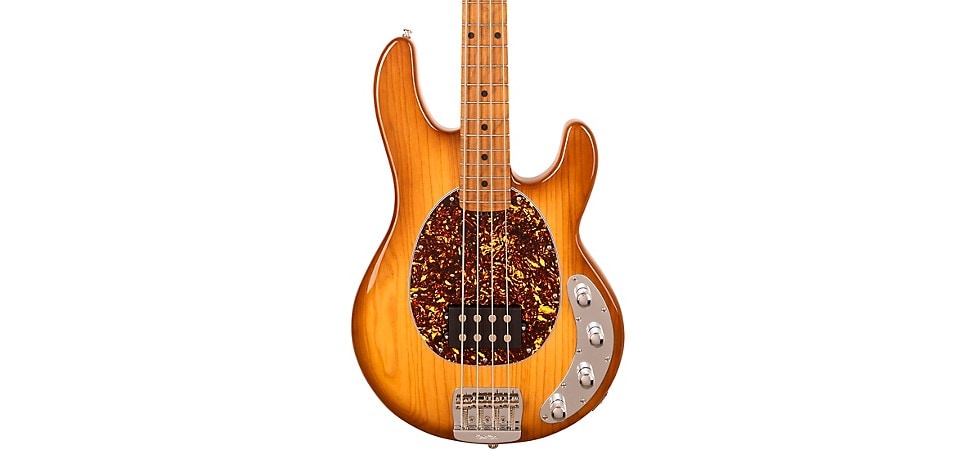
Shop Now: Ernie Ball Music Man StingRay Special H Hot Honey
Hofner Violin Bass
Debuting in 1956, the Hofner Violin Bass became forever known as “The Beatle Bass” when Sir Paul McCartney played his 1961 model on the Beatles’ American television debut on the Ed Sullivan Show in 1963. The shape originated with the fact that most of the builders at Hofner’s factory were violin makers, and it was a shape and construction they could easily adapt to. This short-scale (30”) instrument features rich low end with an almost tuba-like resonance.
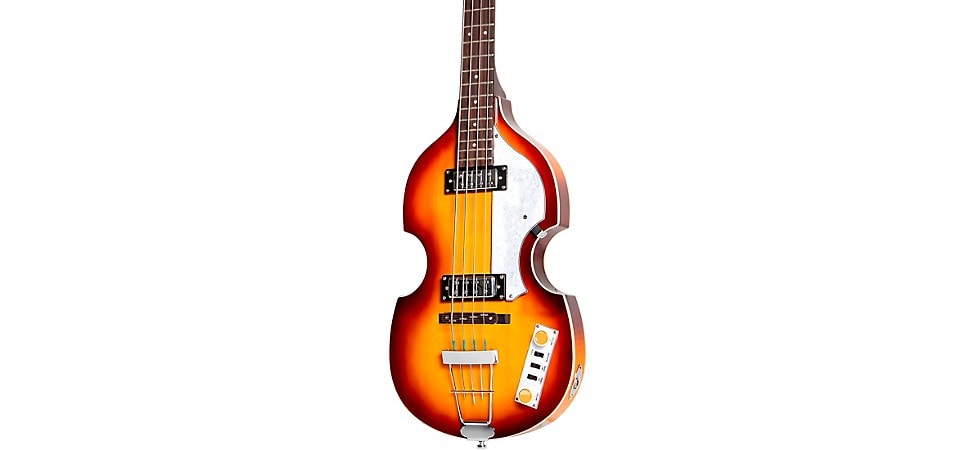
Shop Now: Hofner Ignition Series Violin Bass
Rickenbacker 4000 Series Bass
Another electric bass guitar with a surge in popularity directly attributable to Sir Paul McCartney is the Rickenbacker 4000 series. Though Macca continued to play his Hofner bass onstage, beginning in 1965, his 4001s became his go-to instrument in the studio. With its neck-thru design and unique 33.25” scale length, the contemporary 4003 model boasts a slightly wider neck and hotter pickups, but still carries the signature Rickenbacker tone that balances the warmth of a short scale with the snappier high frequencies of a long-scale bass.
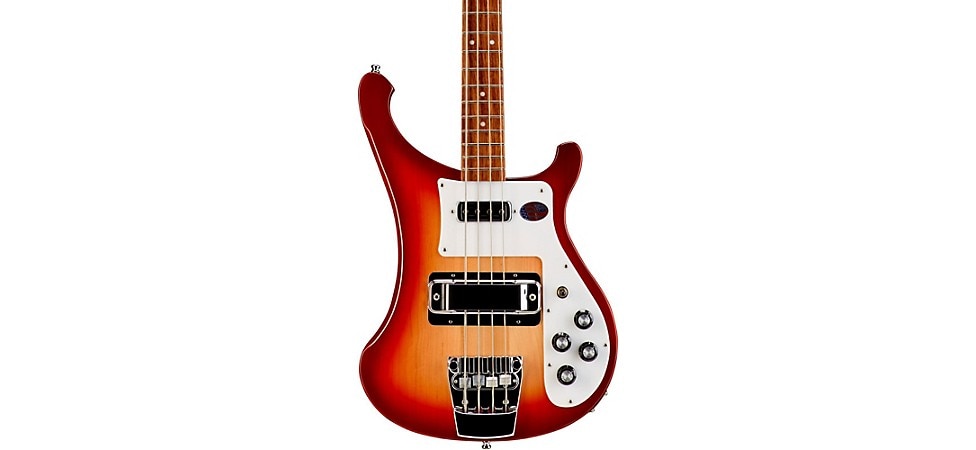
Shop Now: Rickenbacker 4003S Electric Bass Guitar
Epiphone Thunderbird '64 Bass
The original Gibson Thunderbird bass—designed by legendary automotive designer Ray Dietrich—celebrates its 60th anniversary in 2024. As a proper homage, Epiphone recreated a timeless rock bass with the same swagger and soul as the original. The vintage-inspired Epiphone Thunderbird ’64 retains important classic elements, like the original’s 9-ply walnut/mahogany neck-through-body construction, and its pickguard stamped with the recognizable T-Bird logo. In looks and feel, the Epiphone Thunderbird ’64 oozes effortless cool, just like it did all those years ago.
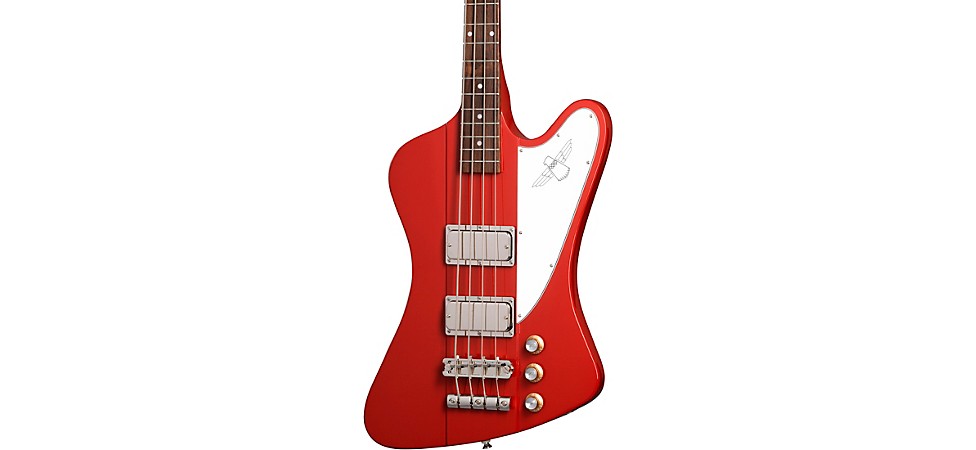
Shop Now: Epiphone Thunderbird '64 Electric Bass Guitar Ember Red
A pair of ProBucker 760 bass humbuckers deliver harmonically rich, powerful tone, while CTS potentiometers hardwire the Thunderbird ’64 to soar like never before. Contemporary improvements include a rock-solid Graph Tech nut, supported by ultrastable clover-buttoned tuning machines utilizing a 19:1 gear ratio. Rev up and hit the stage with one of three eye-catching, auto-inspired colors, and watch heads turn to appreciate an instantly recognizable icon—the Epiphone Thunderbird ’64.
Epiphone Embassy Bass
Epiphone first introduced their Embassy Bass in 1963, building them on the same line as the also-new Gibson Thunderbird. Then, as now, the Embassy offered great long-scale performance and solid humbucker sound in a body style that was just enough off the beaten path to carve its own look. Today’s Embassy Bass carries a vintage aesthetic, but not one that’s buried in nostalgia. Tonally, it strikes a balance between a single-coil short- or medium-scale bass and a long scale, thanks to Epiphone’s Probucker pickups.
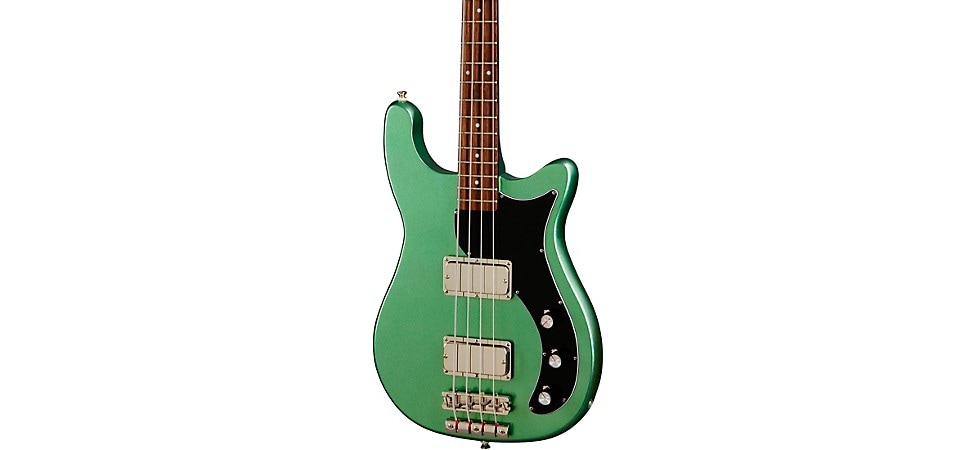
Shop Now: Epiphone Embassy Bass
Five- and six-string options
Many jazz/fusion and prog-metal bassists are turning to five- and six-string basses, also known as extended-range basses. With the addition of a low B string and, on the 6-string extended range, a high C, bassists have the ability to get far, far heavier tones and to extend the harmonic range of solos. Best of both worlds, right? But this increased freedom does have some impact on the instrument’s design that you’ll want to consider before choosing one.
First of all, extended range basses tend to have longer, 35” or more, scale lengths to keep that low B string from being too floppy. This means you’ll have to stretch more in the lower range of the bass. Combine this with the necessarily wider neck, and you’ll find that you’ll have to adapt to reaching further for notes. Switch to a 6-string, and the neck gets wider yet, so it becomes more important to approach it with proper technique (keep that wrist straight) to avoid problems.
Secondly, the added tension of extra bass strings means the neck is probably going to have to be a bit chunkier, even with modern carbon graphite rod reinforcement. After all, you’ve got in the general vicinity of 200 pounds of tension on a 6-string bass neck, and if you’re not planning on using it to shoot arrows, you need some serious strength there.
Both the above factors also mean that your extended-range bass is going to weigh more, so balance and comfort will be important things to look for. All this being said, a five- or six-string bass can really extend (see what we did there?) a player’s musical choices, so let’s look at some of the great choices we have available.
Fender American Ultra Jazz Bass V
The Fender American Ultra Jazz Bass features a rethought neck profile that helps compensate for the added width. The noiseless pickups and active preamp can easily go from classic J-Bass vocal-like sweetness to aggressive attack accentuated by the low B string. The preamp can also be easily switched out for fully passive operation.
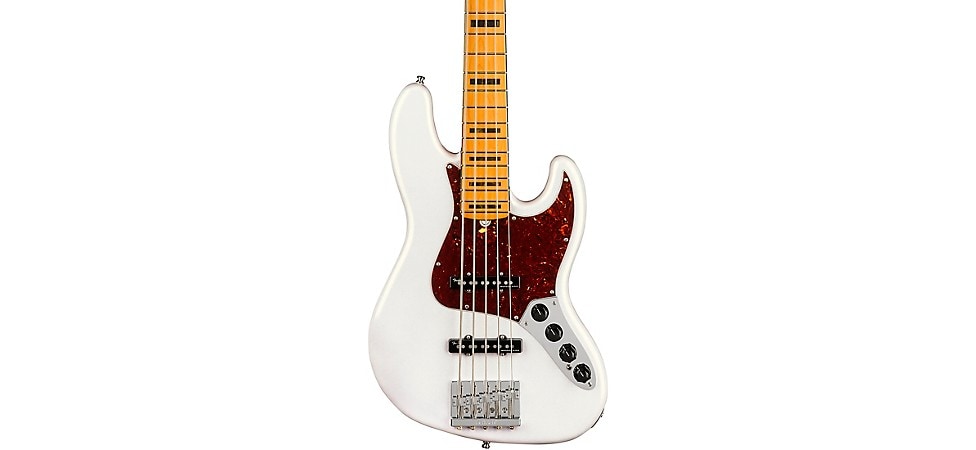
Shop Now: Fender American Ultra Jazz Bass V 5-String Maple Fingerboard
Fender American Ultra II Jazz Bass V
The Fender American Ultra II Jazz Bass V features a Modern D neck profile, compound-radius (10"–14") and Ultra rolled edges that help make it a breeze to play—even with the added width of a five-stringer. The Noiseless pickups and active preamp can easily go from classic J Bass vocal-like sweetness to aggressive attack accentuated by the low B string. The preamp can also be easily switched out for fully passive operation.

Shop Now: Fender American Ultra II Jazz Bass V in Avalanche
Schecter Stiletto Stealth Bass
The Stilleto Stealth from Schecter Guitar Research offers a combination of neck single coil and bridge humbucker for a wide range of tones, and a deferrable two-band EQ to fully contour your sound.
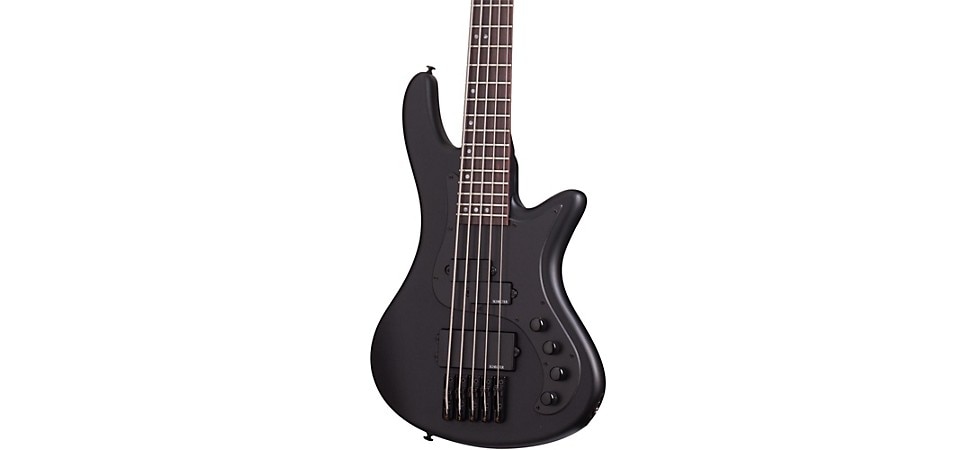
Shop Now: Schecter Guitar Research Stiletto Stealth-5
Ernie Ball Music Man Bongo 6 Bass
Ernie Ball Music Man’s Bongo 6 delivers seriously modern styling in a 6-string bass guitar that’s designed for tonal versatility. With a four-band EQ and custom neodymium humbuckers, there’s a world of sounds at your fingertips. The easy upper-fret access makes it ideal for jazz and fusion players looking to expand their range.
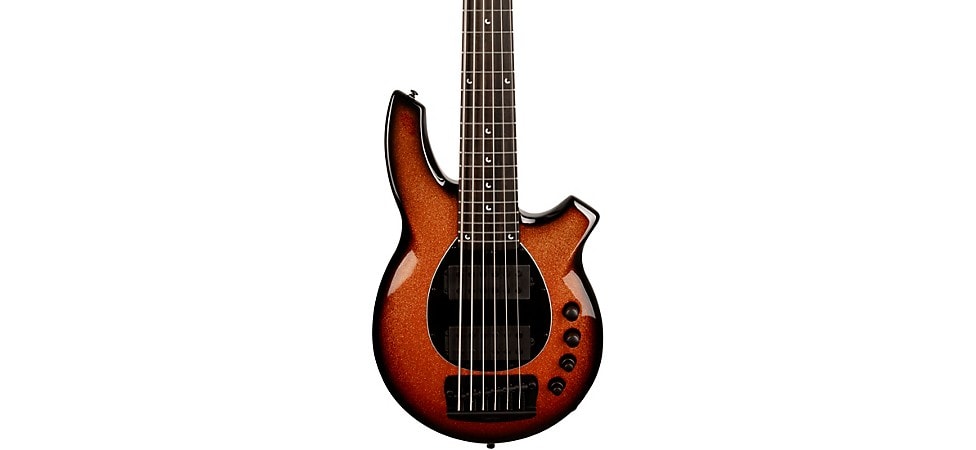
Shop Now: Ernie Ball Music Man Bongo 6
Short-Scale Basses
We touched on short-scale basses in an earlier section, but it’s time to dig a little deeper into the legitimate cool factor of this more compact form factor.
Historically, short-scale basses have tended to be dismissed as strictly a bass for younger students. Nothing could be farther from the truth. Short-scale basses have advantages far beyond just being easier to play for smaller hands. For one thing, you shouldn’t just dismiss that whole “easier to play” thing. Unless you like to suffer, easier is better. And if you’re a guitar player who’s thinking about doubling on bass, it’s a lot easier to go back and forth between instruments, given the closer relation between scale lengths.
Another element, and a big one for many, is the tonal difference between short- and long-scale instruments. Short-scale basses generally sound absolutely huge. This has to do with a couple of physical factors. First, the shorter strings carry less tension and so vibrate more easily. Second, as we mentioned before, different scale lengths change the ratios of the various harmonics generated by the string. So where a longer string with higher tension will generate more higher harmonics, a short-scale bass tends to generate comparatively more lower harmonics, resulting in a bigger, warmer sound. Like we said, huge. This combination of bigger tone and easier to play has seen a lot of players adding a short-scale bass to their collection.
Fender Player Mustang PJ Bass
Stepping beyond Fender’s original 1964 design, substituting a Jazz Bass pickup at the bridge and a Precision Bass pickup in the neck position (commonly referred to as a P/J setup), the Fender Player Mustang PJ brings a new tonal range to the ever-popular Mustang line.
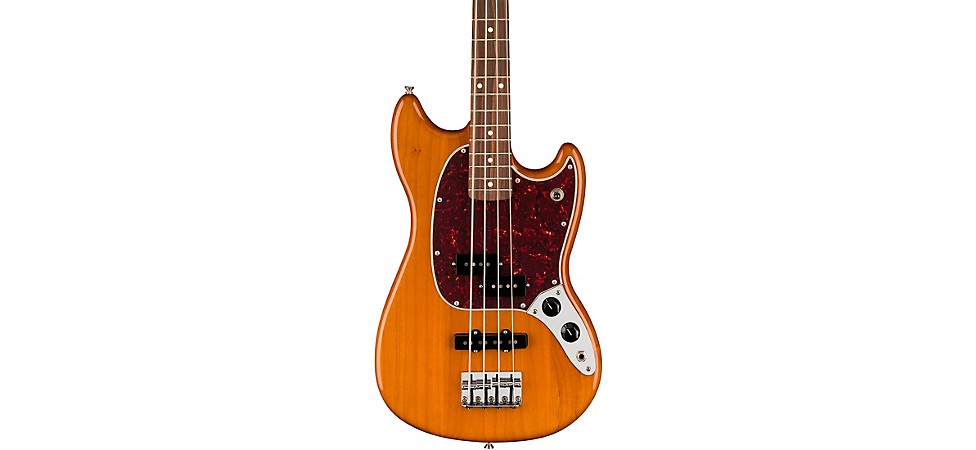
Shop Now: Fender Player Mustang PJ Bass
Fender Player II Mustang PJ Bass
Occasionally overshadowed by the more established superstars in Fender’s bass lineup, the Player II Mustang PJ is an unsung powerhouse with tons of personality and playability. The Mustang Bass originally debuted in 1964 and has been wielded by the likes of Bill Wyman (the Rolling Stones), Tina Weymouth (Talking Heads) and Mikey Way (My Chemical Romance), to name a few. It notably sports a short 30" scale, lending itself to rapid fingerboard navigation and helping young, first-time players, or anyone with smaller hands, feel comfortable on the bass guitar. Featuring a Jazz Bass single coil in the bridge, a Precision Bass split pickup in the middle and a 3-way toggle between them, the Fender Player II Mustang PJ covers tremendous sonic territory. What the Mustang PJ borrows from its bigger siblings, it ingeniously repurposes to rumble and thump with a tone all its own. The Player II Mustang PJ bass is offered in both Rosewood and Maple fingerboard variations.

Shop Now: Fender Player II Mustang PJ Bass with Rosewood Fingerboard in Coral Red
Sterling by Music Man StingRay Short Scale Bass
The StingRay Short Scale from Sterling by Music Man features a passive boost circuit along with the Music Man-designed humbucking pickup and the familiar StingRay body shape.
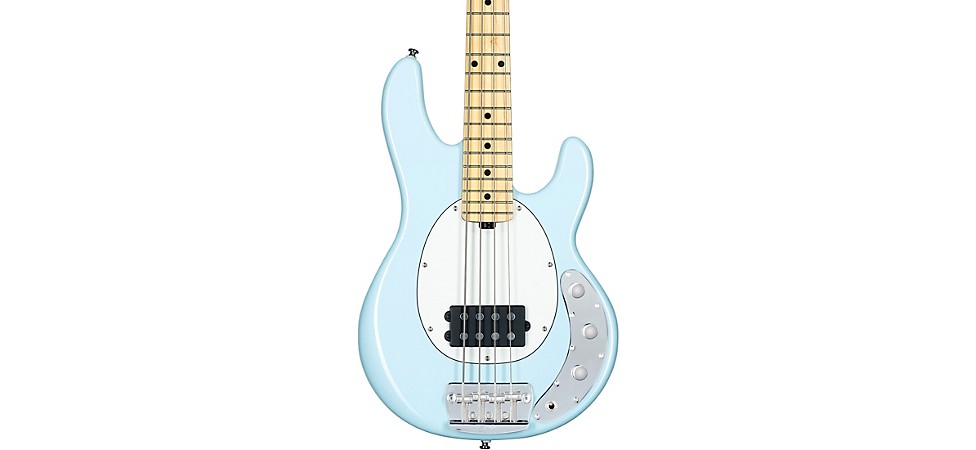
Shop Now: Sterling by Music Man StingRay Short Scale
Ibanez 6-string Multi Short-Scale Ergonomic Headless Bass
The Ibanez EHB1005SMS is an advanced short-scale bass that has several modern features we haven’t discussed here yet. While both headless and multi-scale instruments have been around for some time on specialty instruments, it’s only been fairly recently that the two have been combined on basses intended for the mass market. The unique look of the multi-scale bass, with its angled bridge and nut and frets that resemble a fanned deck of cards, may seem unusual, but there are sound ergonomic reasons. Minimizing wrist bend, which this setup does, helps prevent repetitive stress injuries due to playing. In addition, each string having its own scale length makes for more accurate intonation. This is a great instrument if you’re focused on perfecting technique and expanding the range of your playing.
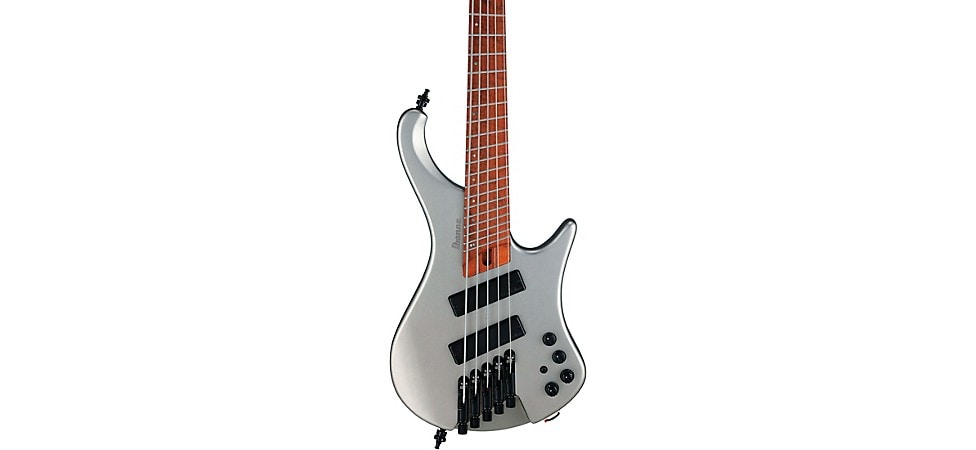
Shop Now: Ibanez EHB1005SMS 5-String
Fretless Bass-ics
We took a brief look at fretless basses in an earlier section. Let’s look a little deeper here at what makes a fretless an attractive choice, and then offer some examples you might want to add to your collection.
The first reason to play a fretless is for the tone. It’s round and warm with a mid-range growl that’s almost vocal in quality. It’s a tone that’s even more unique to the player than usual, because it’s your finger that is actually making the note, not simply pressing a string against a fret. When you listen to different fretless players like Jaco Pastorius, Sting, Bakithi Kumalo (Paul Simon’s bassist on “Graceland”) or The Band’s Rick Danko, the difference in individual touch is what makes each one identifiable almost immediately.
The biggest reason, many players feel, is control. You have more control over all the aspects of the sound of the bass with a fretless because it’s a more direct connection to your hand. And some techniques, like sliding harmonics, aren’t really possible on a fretted instrument. A fretless bass will demand more practice and working on ear training skills, but fretless players, en masse, will say it’s more than worth the effort.
Fender Player Fretless Jazz Bass
The Fender J Bass is one of the most popular choices for fretless, and this Fender Player Series Fretless Jazz Bass is a great example. Featuring comfortably smooth pau ferro fingerboard and a classic J Bass control setup, it’s a great place to stop fretting.
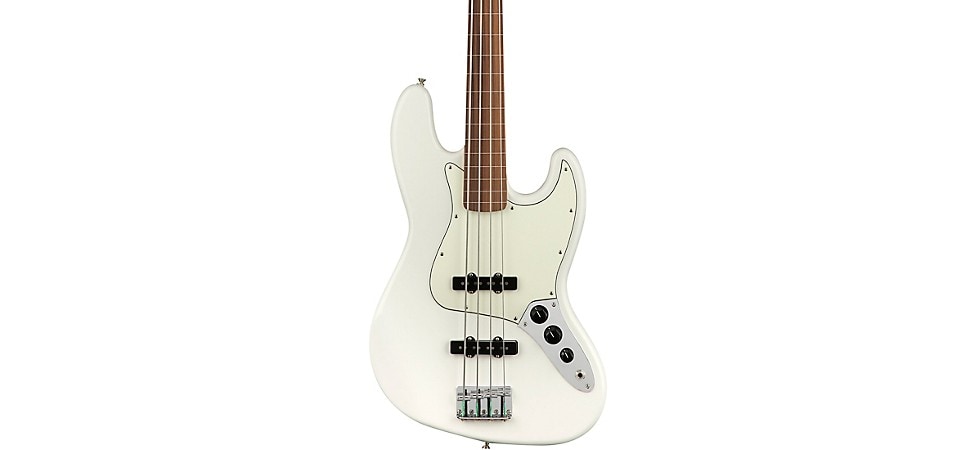
Shop Now: Fender Player Fretless Jazz Bass
Squier Classic Vibe ‘60s Fretless Jazz Bass
For a more vintage take, the Squier Classic Vibe ‘60s Fretless Jazz Bass has the classic sunburst look and responsive alnico pickups.
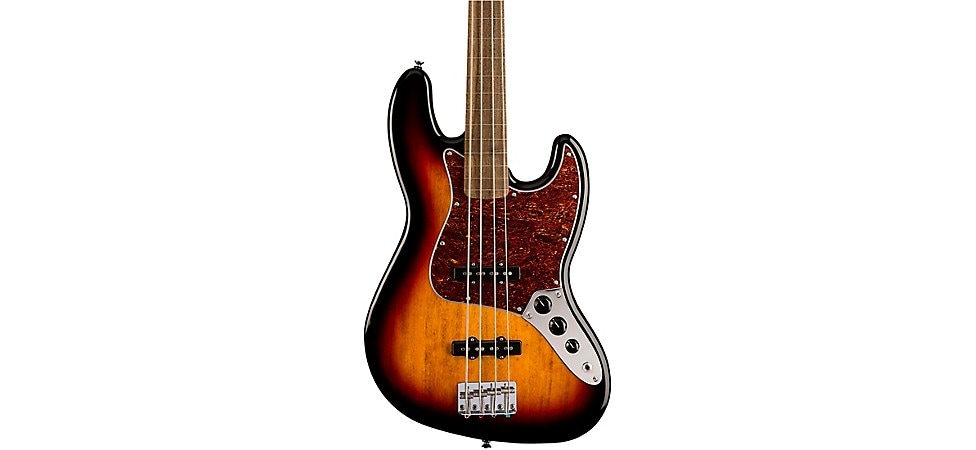
Shop Now: Squier Classic Vibe '60s Fretless Jazz Bass
Rogue LX200BF Fretless Series Bass
With a more modern look and a price tag that makes it easy to see if fretless is for you, the Rogue LX200BF Fretless has a P/J-style pickup configuration and a high-mass bridge for added sustain.
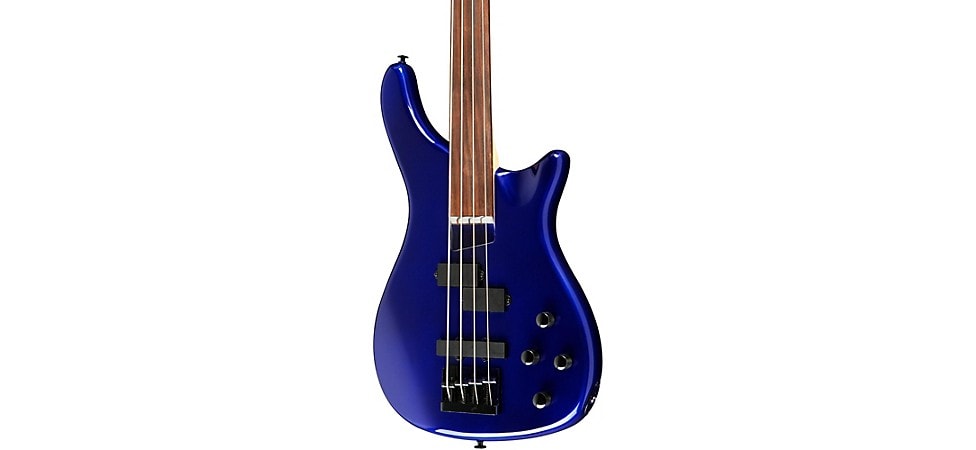
Shop Now: Rogue LX200BF Fretless Series III
Active Basses
You may have noticed us mention a bass as being “active” in a couple of the sections above. Let’s dig a little more into that, since there is more than one way for an electric bass guitar to qualify as an active bass.
At the fundamental level, active means that there are electronics in the guitar that require electricity to work, usually from an onboard battery (occasionally two batteries). What kind of electronics? Usually some form of preampfification for the pickups. On what are called active pickups, the preamp is built into the pickup itself, and the tone controls will still be passive (i.e. only allow for frequency cut, not boost). The big advantage of active pickups is that they are generally low impedance and can drive much longer cable runs without suffering the high-frequency loss that a passive pickup would.
An active preamp system, on the other hand, can be used with either passive or active pickups, and provides both the advantages of a low impedance output we just mentioned, plus active EQ. This EQ can be anything from standard Treble/Bass knobs that can boost, as well as cut, frequencies to a 4-band EQ with sweepable high- and low-mids, offering some serious sonic control.
So, aside from the long and exceptionally quiet cable runs, what are the advantages and disadvantages of the two types of active? It’s all about the tone. Both active pickups and active preamp systems deliver a cleaner, more full-bandwidth signal to your amp or recording interface/console, sounding bigger and punchier. With the active preamp’s EQ section, you can contour your sound in much more detail.
There are really only two minor drawbacks here. First, an active system can sometimes result in a slightly “compressed” sound that has a little less dynamics. Generally, this is because the system is slightly underpowered, either because it’s time to change the batteries, or you’re playing aggressively enough that you’re running up against the available headroom of the preamp. If the latter is the case, and you’re running on only a single 9-volt battery, you can usually solve it by upgrading to a dual-battery, 18V power supply. (Pro Tip: The techs at Guitar Center Repairs will be glad to help you out with that). The second problem is also battery related. With a purely active system, when the battery goes dead, the bass goes dead. This is why almost all active preamp systems have a bypass switch that enables the bass to run in passive mode.
Now that you know the upside and the potential downside of active basses, we’ll take a look at a few choices that can really punch up your sound.
Fender American Ultra II Meteora Bass
Those who are torn between that classic Fender vibe and something with a more unconventional streak—but have their heart set on a more aspirational instrument—should plug in an American Ultra II Meteora Bass for a test ride. Striking offset looks flaunting sharp curvature aside, it comprises a pair of Haymaker bridge and middle humbuckers, as well as all the other hardware appointments of the previously mentioned Am Ultra II models in this guide to give you unprecedented tonal versatility. Get yours with a quartersawn maple or ebony fingerboard.

Shop Now: Fender American Ultra II Meteora Bass in Ultraburst
Sterling by Music Man StingRay Ray34 Bass
The original StingRay was the first bass to have an active preamp, and this Sterling by Music Man StingRay Ray34 makes that Music Man-designed 3-band EQ and alnico humbucker more accessible than ever. The incredible looks don’t hurt, either.
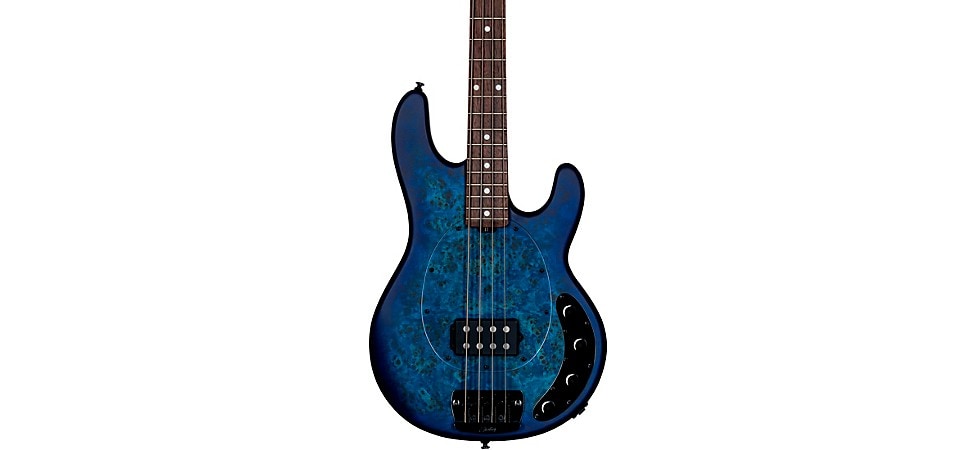
Shop Now: Sterling by Music Man StingRay Ray34
Jackson Adam Blackstone "Gladys" Bass
Adam Blackstone is an infinitely talented multi-instrumentalist, songwriter and musical director, best known for his work with Nicki Minaj, Rihanna and Justin Timberlake. His signature Jackson Adam Blackstone “Gladys” 5-string bass takes cues from the Concert Bass, with a slightly more refined, traditional aesthetic. Featuring custom passive Jackson J-style bass pickups and active 3-band EQ, Blackstone’s signature bass traverses everything from modern pop to rock, and classic jazz to neo soul.
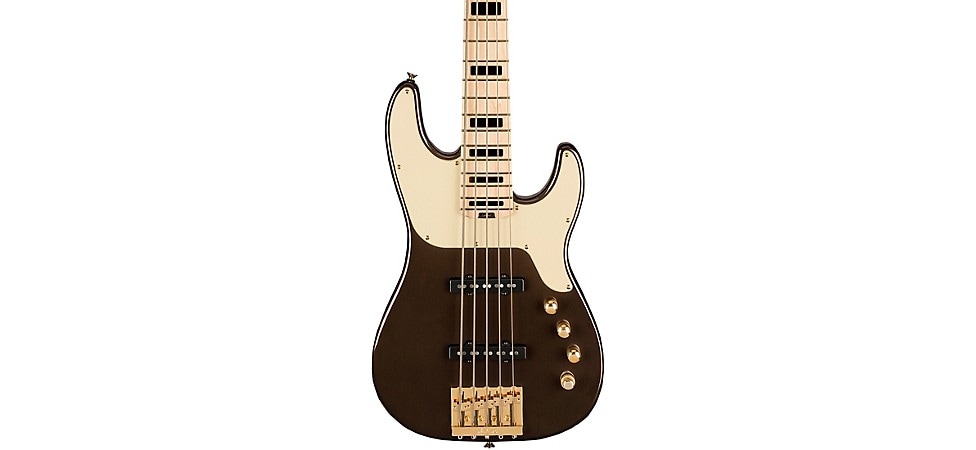
Shop Now: Jacskon Adam Blackstone "Gladys" 5-String Bass
Jackson X Series Concert Bass
The Jackson X Series Concert Bass features Jackson’s trademark aggressive styling and a graphite-reinforced neck-thru design. The PJ-style pickup configuration is enhanced by active 3-band EQ. This bass is definitely aimed at the rock and metal player.

Shop Now: Jackson X Series Concert Bass
Mitchell MB200 Modern Rock Bass
Mitchell’s MB200 Modern Rock Bass is a great, easy way to add a bass with an active preamp to your arsenal. Featuring a 2-band active EQ for its P/J-style pickups and a high-mass bridge for extra tone and sustain, it’s a versatile, multi-genre monster.
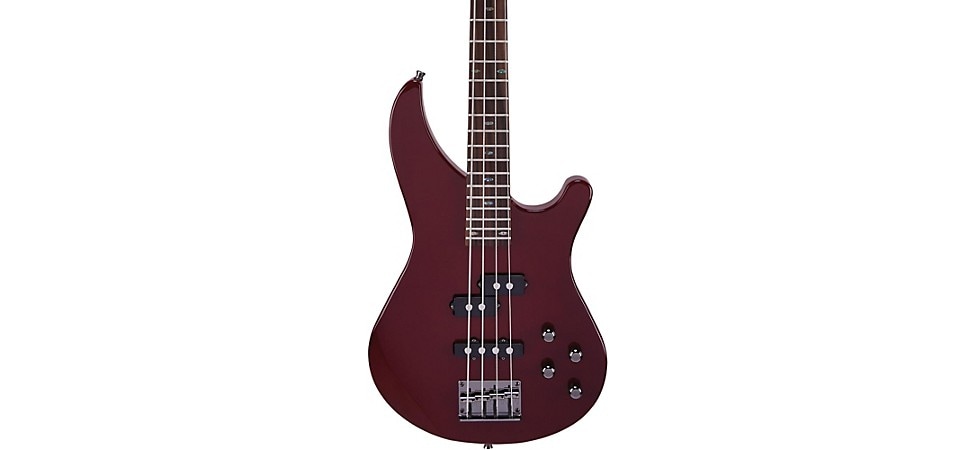
Shop Now: Mitchell MB200 Modern Rock Bass
Acoustic Basses
Up to this point, we’ve been talking strictly about purely electric basses. But for almost fifty years, there have been acoustic and acoustic-electric bass guitars that are a great addition to every bassist’s collection (Trivia: The first modern acoustic bass guitar was the Ernie Ball Earthwood Bass, which debuted in 1972.) There are some excellent reasons why you might want to add one to yours.
First, the ability to play it acoustically means that it’s a great practice instrument. No need for an amp or headphones, or any source of electricity whatsoever. Just pick it up and start working on your chops, wherever you may be at the time. An acoustic bass guitar also makes it easy to get together with friends and jam without all the hassle of setting up amps and a sound system or renting rehearsal space.
Second, it’s a great way to get a different sound. Different tonewood combinations will have more effect on your sound, and the resonance and sustain of an acoustic instrument offer a new texture to use in varied musical situations. Plus, you’ll be ready if MTV ever brings back Unplugged. Most acoustic bass guitars today come with internal pickup/mic systems, so you can still plug it in and get that big acoustic sound onstage. Here are some great choices to consider.
Guild B-140E Westerly Collection Jumbo Acoustic-Electric Bass
Most familiar from Nirvana’s performance on Unplugged, for which it earned a place in the Rock and Roll Hall of Fame, the Guild B-140E harkens back to their early entry into the acoustic bass world. In the mid-1970s Guild struck a (low) chord with the B-50, a bass version of their venerable D-50 dreadnought guitar. Featuring all-solid wood construction with a spruce top and mahogany back and sides, this is one sweet-sounding bass, either purely acoustic or using the internal Fishman Sonitone bass pickup system.
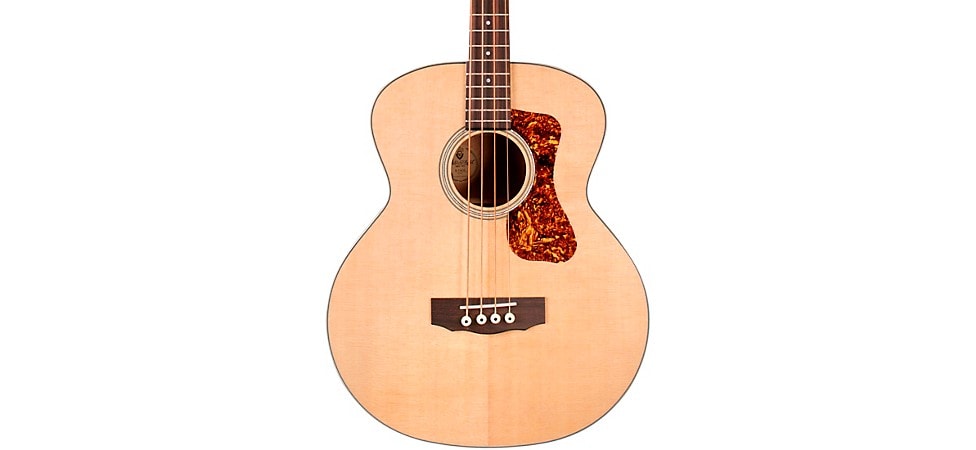
Shop Now: Guild B-140E Westerly Collection Jumbo
Fender Kingman V2 Acoustic-Electric Bass
The short-scale Fender Kingman V2 is designed for comfort with an easy-playing 30”-scale Jazz Bass neck married to a solid spruce top and mahogany back and sides. The cutaway body makes it abundantly clear this one is ready to rock.
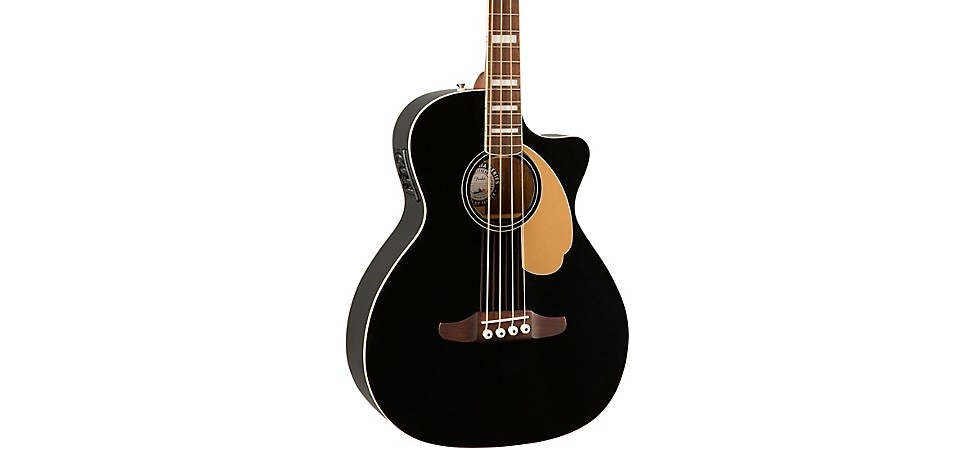
Shop Now: Fender Kingman V2 Acoustic-Electric
Dean AXS Acoustic-Electric Bass
This Dean AXS Bass is one of the most affordable choices in this category. All-mahogany construction and a full 34”-scale neck strike a great balance between acoustic warmth and taut, piano-like lows. A Dean SL3 preamp offers easy tone adjustments when you’re plugged in, and a built-in tuner whether you are or not.
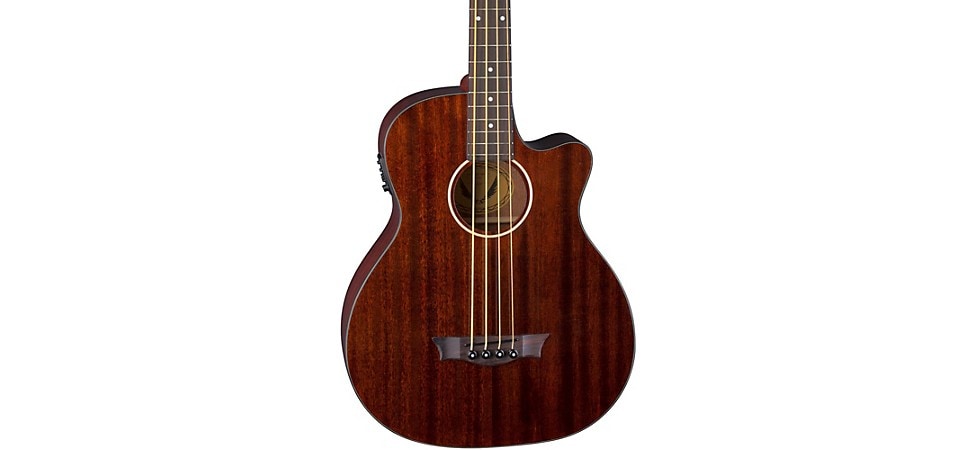
Shop Now: Dean AXS Acoustic-Electric
Best Beginner Choices
We’ve looked at a wide range of basses up to this point, but we’d like to take a little time to look at some of the best choices Guitar Center has for instruments for the beginning bass player. There are a few criteria that go into making a great electric bass guitar for beginners:
- It needs to be comfortable to play. When you’re starting, you need to play a lot. Heck, you want to play a lot. The more comfortable your instrument is to play, the easier that is.
- A beginner bass should offer great value for the money. Affordable is relative, and sometimes a beginner will start off on a pro-level bass because they can. But if it’s easy for you to buy, it’s easier to just get started playing. Better to keep that boutique custom shop bass in the back of your mind and set it as a reward for yourself when you hit a particular goal, then put off getting started any longer.
- It should sound good—maybe even awesome. The better it sounds, the more you’ll play. This leads us to the last point.
- Your first bass should make you want to keep playing. If your instrument ticks off all the points above, you should look forward to every practice session, then every jam with friends, then every band rehearsal and so on. Music is fun, and it shouldn’t hurt. Now go get ‘em! But one last word before we get to our final list.
While lots of musicians, including some pretty famous ones, are self-taught, you’re always better off starting with a good instructor to make sure you’ve got proper technique down from the get-go. And sometimes you need someone to help nudge you back on track if you wander off. Guitar Center Lessons, both in-store and online, are a great way to get started, get back to playing after a long hiatus, or simply to refine your skills. We’ve got instructors at all levels, in all styles, and it’s easy to set up a lesson plan and schedule that will work for you.
That being said, if you are just starting on your musical journey through the land of low-frequencies, here are some really solid choices to get off on the right foot.
Jackson Limited-Edition JS Series Concert Bass
Nothing screams “Rock!” more than neon colors and classic Jackson styling. This limited-edition Jackson JS Series Bass dazzles the eye and the ear at a great price.
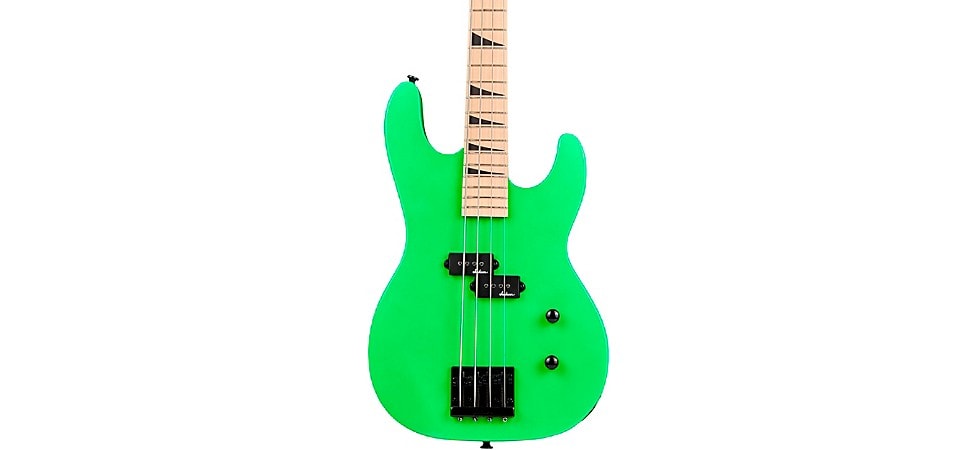
Shop Now: Jackson Limited-Edition JS Series
Sire Marcus Miller V3 4-string Bass
Legendary jazz/funk bassist Marcus Miller wanted to make sure that anybody could afford a bass that met his standards, so he teamed up with Sire. Like its namesake, it easily goes from aggressive thumb-popping funk to straight ahead jazz. Also a great instrument to use with pedals, the Sire Marcus Miller V3 4-string is one of the most affordable long-scale active basses, with Miller’s signature 3-band EQ a big plus.
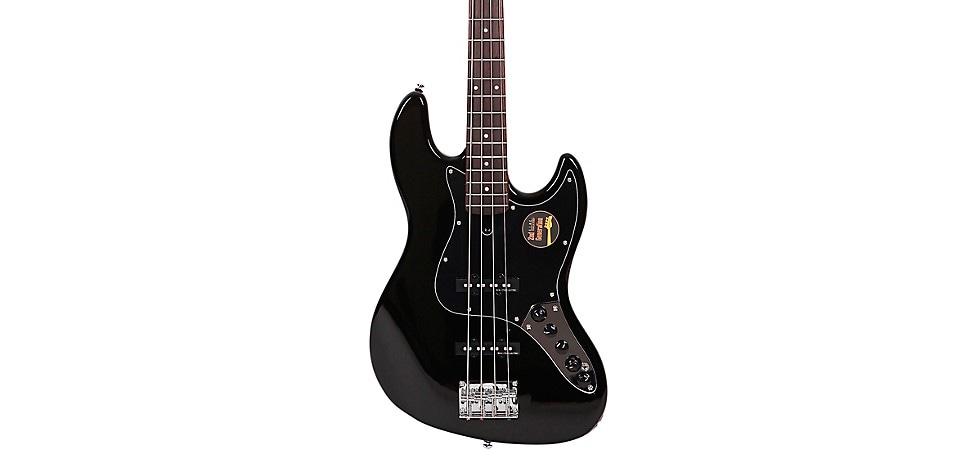
Shop Now: Sire Marcus Miller V3
Ibanez TMB100 Bass
Sporting a retro-look body style and active 2-band EQ, the 34”-scale Ibanez TMB100 packs standout features into a seriously affordable package.
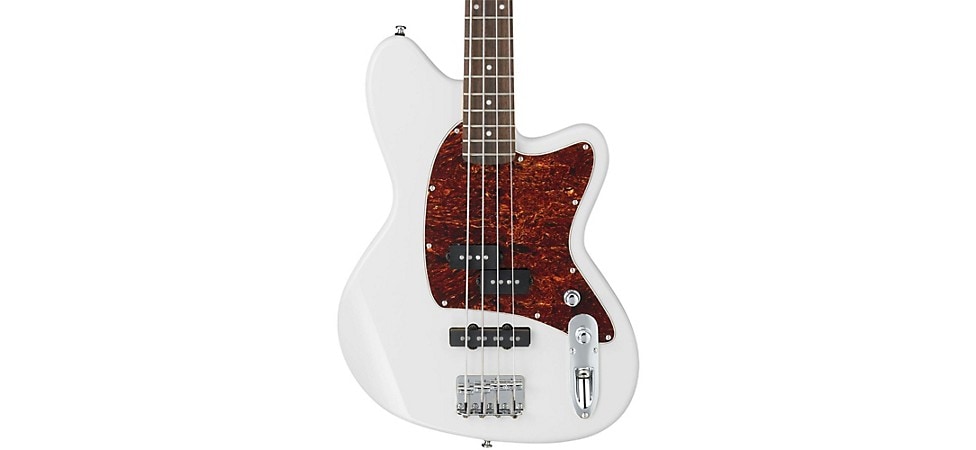
Shop Now: Ibanez TMB100
Mitchell MB100 Short-Scale Bass
The Mitchell MB100 Short-Scale Bass pulls together a sleek, modern body style with PJ-style pickups and an easy-to-play 30”-scale for smaller hands or guitar players looking for a comfortable entry into the world of bass.
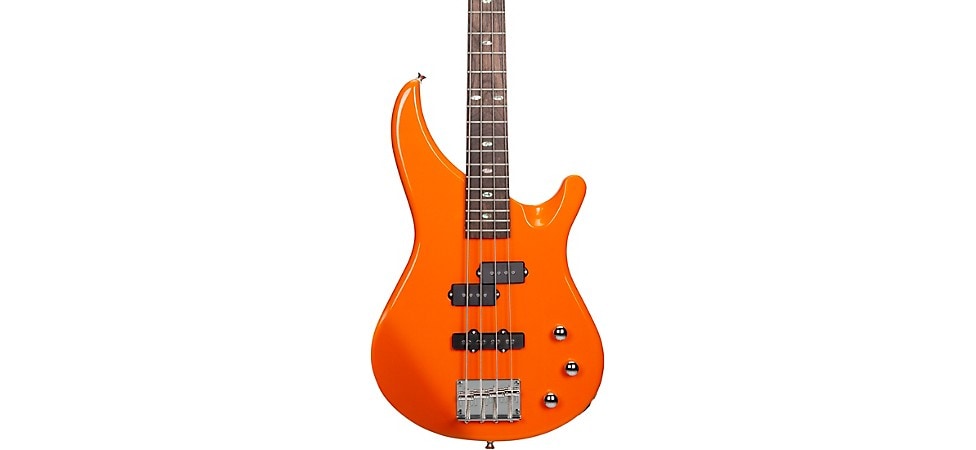
Shop Now: Mitchell MB100 Short Scale
The Bottom Line
Now that we’ve laid it all out for you, the next step is the hardest one—deciding which of these basses will be the right one for you. If you’re having trouble making up your mind, please stop in at your local Guitar Center and talk with an associate, or call 855-770-3373 to speak to one of our knowledgeable Gear Advisers. We want to make sure you get the right bass so that you can help keep the music going.




